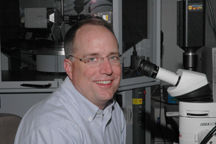
Bruce Noll, research associate professor in the Department of Chemistry and Biochemistry, was a high school dropout.
I worked for a family business, but it wasnt my family,he says.I realized Id gone as far as I could go, and it wasnt going to get any easier to go back to school. It would only get harder as I got older.
He started college at age 24, and graduated from the University of California, Davis, in 1999, with a doctorate in inorganic chemistry and a specialization in crystallography.
He came to Notre Dame in 2003 to direct one of the best-equipped X-ray crystallography labs in the countrya lab used by graduate students and upper-level undergraduates to perform basic, curiosity-driven research. The goal is not any specific application, but rather the advancement of science.
Notre Dames outstanding X-ray crystallography facility is the result of efforts spearheaded by professors Kenneth W. Hendersonwhose research specialty is organometallic and supramolecular synthesisand Slavi C. Sevov, whose broad area of expertise is inorganic and solid state chemistry.
There are other places that have the numbers of equipment,Noll says,but there are few with the quality. Other colleges and universities have facilities, but may lack a trained crystallographer.
The lab has three state-of-the-art single-crystal diffractometers and one state-of-the-art powder diffractometer. It also is equipped with two polarizing stereomicroscopes, one of which can capture digital images. All of the instruments are available for student use.
As a research professor, Noll does not teach classes.
I participate in classes taught by the teaching and research faculty,he says,and I support the ongoing research in the other laboratories in the department.
Most of his time is spent helping students set up experiments, training new users, and analyzing the results.
They have all the fun, I see all the problems,he says.One of the good things is that I get to work with so many students and post-docs.
In the simplest terms, what the X-ray crystallography lab does is look at atoms to determine the structure of molecules or chemical compounds. Scientists must determine (solve) the atomic-resolution structure of the molecule or compound to allow further research. If a super-saturated solution of a chemical can grow a crystal, the atomic structure can be examined through diffractionfrom the Latin word meaningto break apart.
Atoms cant be viewed under visible light, so the crystal is bathed in X-rays.
The X-rays hit the crystal and diffract in all different directions, creating a pattern,Noll explains.
The diffractometers X-ray detectoressentially a complicated digital camerais cooled to minus 60 degrees Celsius with liquid nitrogen (the same stuff the doctor uses to remove a wart), reducing the vibrations in the atoms. As the crystal is rotated under the microscope, the shifting patterns of diffraction are recorded and the images combined, revealing the positions and types of atoms in the crystal. The resulting three-dimensionalmapis the atomic resolution model.
A drug company might map the structure of a molecule to determine how it interacts with a protein.
It might allow them to fine-tune the therapeutic properties,Noll says.
In addition to research into pharmaceuticals, the lab also conducts research into compounds that may be useful as catalysts for petroleum refining. Other ongoing research includes the study of nano and magnetic materials, and the development of models for heme proteinsthe pigment that makes blood redin hemoglobin.
The research, Noll says, will likely have many applications in the real world. But thats not the point.
Were doing it to advance basic knowledge,he says.Its to expand our understanding of the system. It provides a starting point for researchers at the next level who are looking for answers.
TopicID: 23826